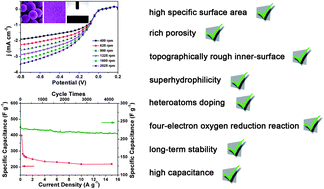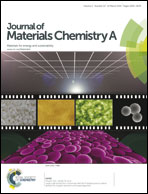Large scale production of biomass-derived N-doped porous carbon spheres for oxygen reduction and supercapacitors†
Abstract
The urgent need for sustainable energy development depends on the progress of green technologies, which have steered hot research areas into environmentally benign approaches via inexpensive precursors and abundant resources obtained directly from nature for energy devices such as fuel cells and supercapacitors. By using fermented rice as starting materials, we herein demonstrate a facile, green and scalable approach to synthesize porous N-doped carbon spheres characterised by high specific surface areas (2105.9 m2 g−1) and high porosity (1.14 cm3 g−1), which exhibit not only excellent electrocatalytic activity toward the four-electron oxygen reduction reaction with long-term stability for fuel cells, but also have excellent resistance to crossover effects and CO poisoning superior to that of the commercial Pt/C catalyst. Furthermore, the naturally derived porous N-doped carbon spheres, used as the active electrode materials, present superior performance for capacitors with a capacitance of 219 F g−1 at a high discharge current density of 15 A g−1 and good cycling stability for over 4400 cycles. This work shows a good example for taking advantage of the abundant resources provided by nature, and opening the door for the creation of functional materials with promising applications in high-performance renewable devices related to energy conversion and storage.


 Please wait while we load your content...
Please wait while we load your content...